Illinois boasts over 2,500 native plant species, yet most homeowners unknowingly struggle with finicky non-natives that demand constant water, fertilizer, and pest control. You’ll discover that switching to Midwest natives like Purple Coneflower and Bur Oak eliminates these headaches completely, since they’ve adapted to Illinois’ clay soils and unpredictable weather patterns over thousands of years. The secret lies in understanding which specific natives match your garden’s unique conditions.
Contents
- 1 Illinois Soil and Weather Patterns
- 2 Illinois Prairie Wildflowers
- 3 Illinois Native Shade Trees
- 4 Illinois Native Understory Shrubs
- 5 Selecting the Right Native Plants for Your Garden
- 6 Frequently Asked Questions
- 6.1 Where Can I Purchase Native Illinois Plants and Seeds Locally?
- 6.2 How Do I Remove Invasive Species Before Planting Native Plants?
- 6.3 What Is the Best Time of Year to Plant Native Species?
- 6.4 Do Native Plants Require Special Fertilizers or Soil Amendments?
- 6.5 How Long Does It Take for Native Plants to Become Established?
Illinois Soil and Weather Patterns
Before you can successfully grow native plants in your Illinois garden, you’ll need to understand the soil beneath your feet and the weather patterns that shape your growing conditions. Illinois boasts over 700 different soil types, from fertile Mollisols to poorly-drained Drummer soil. The state’s official soil, Drummer, features black silty clay loam topsoil with excellent moisture retention. The optimal pH for nutrient uptake is around 6.5, though some native plants may prefer more acidic or alkaline conditions.
Your growing season spans 160-190 days, depending on location. Annual precipitation averages 36-48 inches, with spring’s frequent rainfall supporting plant establishment. Summer heat combined with clay-rich soils can stress moisture-loving species, while winter’s freeze-thaw cycles naturally break up heavy soils.
Illinois Prairie Wildflowers
Illinois prairie wildflowers showcase remarkable diversity with distinctive blooming seasons, specialized habitats, essential pollinator partnerships, and unique identifying characteristics across multiple native ecosystems. These native species thrive in five distinct categories including black soil prairie, gravel prairie, dolomite prairie, sand prairie, and hill prairie environments.
Wild Bergamot (Monarda Fistulosa)

Wild Bergamot (Monarda fistulosa) is a hardy Illinois native perennial that produces distinctive firework-shaped flower heads in shades of lavender, pink, or white from May through September. Growing 2½–5 feet tall with aromatic, gray-green foliage that releases a minty, oregano-like fragrance when crushed, this prairie wildflower features four-angled stems and opposite leaves.
This adaptable native excels in prairie gardens, naturalized plantings, and pollinator gardens, providing vital nectar for hummingbirds, butterflies, and native bees. The plant spreads through shallow rhizomes, creating colonies that can establish in disturbed areas and even survive earth-moving operations. Historically valued for medicinal teas and essential oils, Wild Bergamot remains a low-maintenance choice that thrives in varied conditions while supporting biodiversity in native landscape restorations.
- Hardiness: USDA zones 3-9
- Light: Full sun to partial shade
- Water: Drought tolerant; prefers dry to mesic conditions, avoid wet or poorly drained sites
- Soil: Adaptable to various soil types, well-draining preferred
- Fertilizer: Low fertility requirements, thrives in native soils without supplemental feeding
- Pest/Disease Resistance: Generally resistant to pests and diseases as a hardy native
- Growth Rate: Moderate to fast, establishing readily in suitable conditions
Purple Coneflower (Echinacea Purpurea)
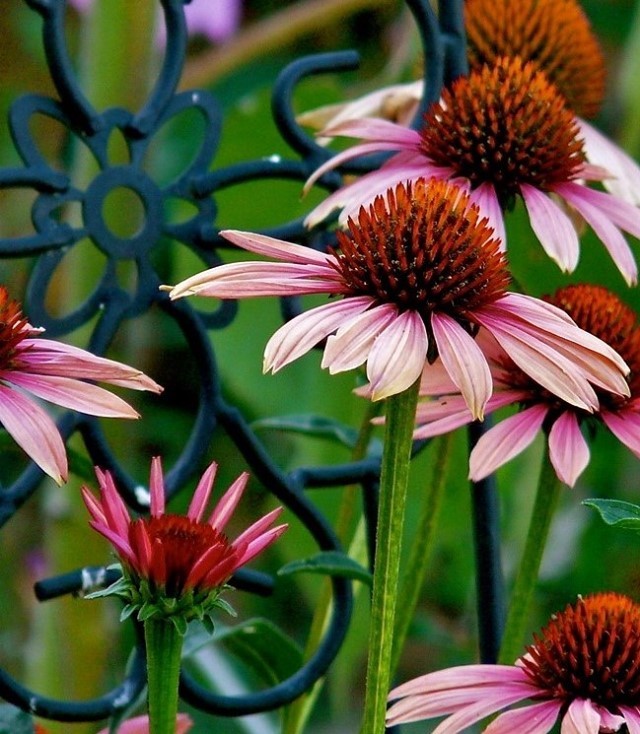
Purple Coneflower (Echinacea purpurea) is a striking perennial wildflower native to Illinois prairies, growing up to 3½ feet tall with distinctive pink to red-purple drooping petals surrounding a prominent coppery-orange spiny center. The four-inch blooms make excellent cut flowers and appear from July through August, though cultivated varieties may bloom from May through September.
This hardy prairie plant thrives in Illinois gardens and restoration projects, self-sowing readily to establish naturalized populations. Its lance-shaped, toothed leaves and light green stems with purple streaks create attractive foliage, while the flowers attract butterflies, bees, and other pollinators, providing important ecological value throughout the growing season. Plants are rarely affected by foliar disease, making them exceptionally reliable for garden cultivation.
- Hardiness: Zones 3-8
- Light: Full sun (6 hours direct light daily) or partial shade (4-6 hours daily)
- Water: Drought resistant but prefers consistent moisture; will wilt in dry conditions with strong sunlight
- Soil: Fertile loam preferred; tolerates some gravel or clay content; requires well-drained conditions
- Fertilizer: Not specified – typically low maintenance as a native prairie plant
- Pest/Disease Resistance: Good resistance typical of native wildflowers
- Growth Rate: Fast establishment and growth rate
Black-Eyed Susan (Rudbeckia Hirta)
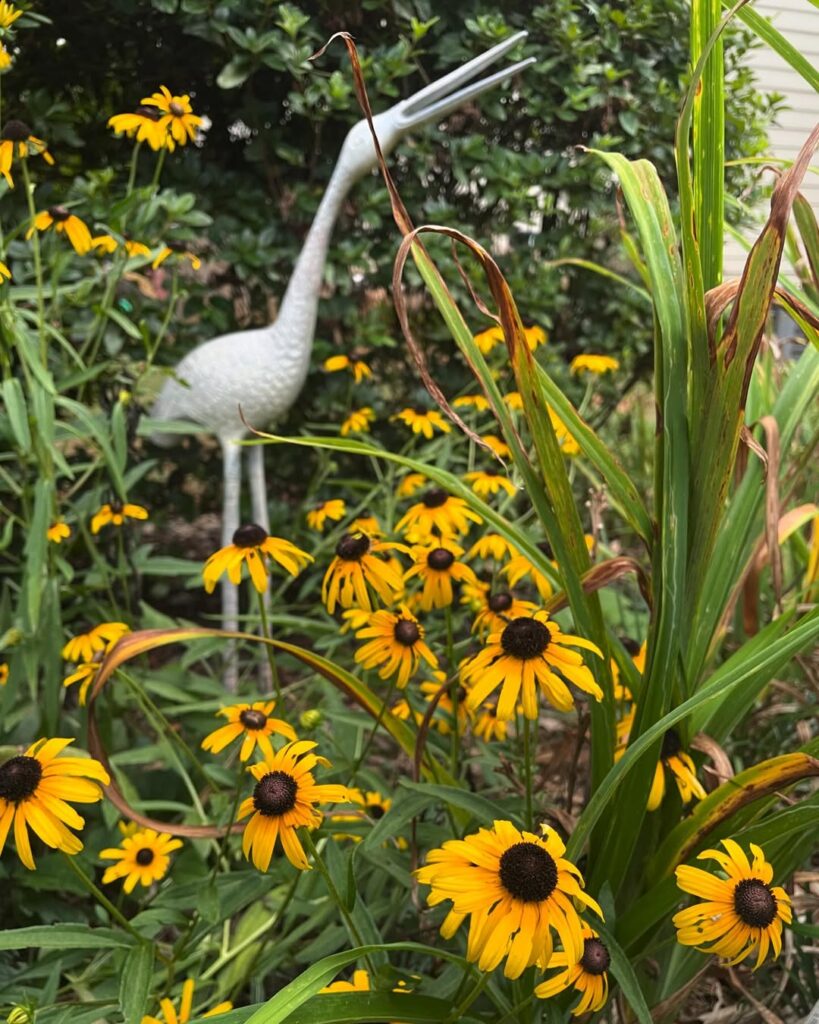
Black-Eyed Susan is a beloved native Illinois wildflower in the Asteraceae family, growing 1-2½ feet tall with distinctive bright yellow ray petals surrounding a purple-brown center. This warm-season forb features coarse, hairy stems and greyish-green lanceolate leaves covered in stiff hairs that give them a rough texture.
Fast-maturing and easy to grow, Black-Eyed Susan can function as an annual, biennial, or short-lived perennial. It produces solitary composite flowers approximately 2.5-2.75 inches wide from summer through early fall. Native to Chicago region prairies and open woods, this adaptable wildflower thrives in various Illinois habitats and makes an excellent choice for prairie restoration projects and naturalized garden areas. The plant attracts various beneficial insects including bees, flies, butterflies, and beetles that visit for nectar and pollen.
- Hardiness: Native to Illinois; tolerant of various growing conditions
- Light: Full sun to partial shade
- Water: Moderate moisture; drought tolerant once established
- Soil: Well-draining; adaptable to various soil types
- Fertilizer: Low fertility requirements; thrives in native conditions
- Pest/Disease Resistance: Generally resistant; occasional powdery mildew in moist conditions
- Growth Rate: Fast to mature; quick establishment from taproot
Wild Lupine (Lupinus Perennis)

Wild Lupine (Lupinus perennis) is the only lupine species native to Illinois, growing 1-2½ feet tall with distinctive palmate compound leaves featuring 7-11 leaflets. This prairie wildflower produces stunning spikes of blue-violet pea-like flowers from April through July, creating bold visual impact in native gardens. Also known as “Sundial Lupine” for its sun-tracking leaves, this uncommon wildflower is found primarily in northeastern Illinois and serves as an important nectar source for butterflies and bees.
The plant thrives in sand hills, clearings, and open woods, forming an essential component of prairie ecosystems. Its hairy seed pods contain 2-7 seeds each and naturally disperse when mature, allowing for self-propagation. With recommended spacing of 1-1½ feet between plants, Wild Lupine adds both ornamental appeal and conservation value to native garden plantings. Wild Lupine fixes nitrogen into the soil through its specialized root system, naturally enriching garden beds for surrounding plants.
- Hardiness: USDA zones 3-8
- Light: Full sun in cooler climates, partial shade in hotter regions
- Water: Dry to moist conditions with good drainage
- Soil: Well-drained, acidic, sandy or loamy soil
- Fertilizer: Low nutrient requirements as native prairie plant
- Pest/Disease Resistance: Generally pest and disease resistant
- Growth Rate: Moderate growth rate, perennial establishment
Wild Indigo (Amorpha Fruticosa)
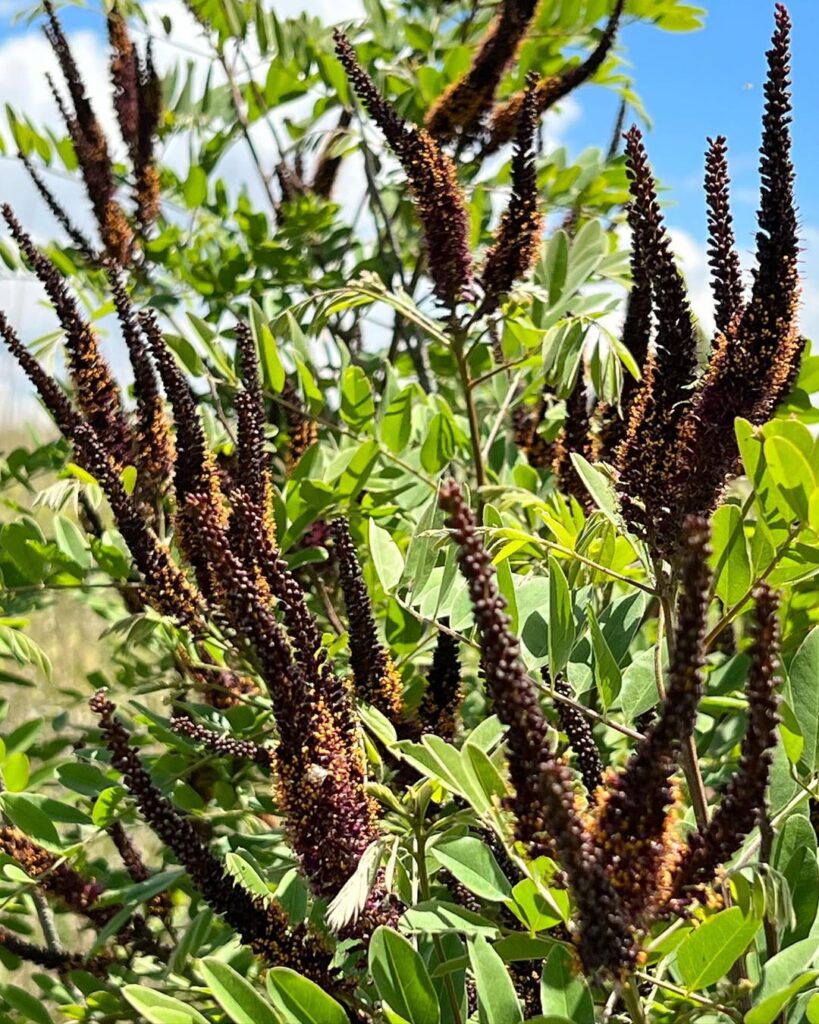
Wild Indigo (Amorpha fruticosa) is a striking medium to large native shrub that reaches 6-12 feet tall with an open, airy growth habit. This deciduous member of the legume family produces spectacular upright flower spikes 3-6 inches long, featuring royal purple blooms with brilliant orange stamens that create a stunning visual contrast from April through June.
Native to Illinois river systems and prairie edges, Wild Indigo forms dense thickets and offers exceptional ecological value as a pollinator magnet. Its compound gray-green leaves and fast growth rate make it an excellent choice for naturalized landscapes, wet areas, and prairie restorations where other shrubs might struggle. The plant thrives in compacted urban soils with low oxygen levels, making it particularly valuable for challenging city environments.
- Hardiness: Zones 5-6 (suitable for Northern Illinois and Chicago region)
- Light: Full sun (6+ hours daily) to partial shade (4-6 hours daily)
- Water: Adaptable from wet to dry conditions; tolerates occasional drought and flooding
- Soil: Highly adaptable to acid, alkaline, sandy, and clay soils
- Fertilizer: Nitrogen-fixing legume requires minimal fertilization
- Pest/Disease Resistance: Generally resistant with few serious issues
- Growth Rate: Fast-growing with multi-stemmed, spreading form
Illinois Native Shade Trees
Illinois native shade trees offer diverse options for landscaping, from prominent oaks and hickories to maples and sycamores, plus unique species and moisture-loving varieties suited to local conditions. The White Oak, which serves as Illinois’ state tree, stands as one of the most distinguished native shade options for homeowners seeking both beauty and heritage in their landscape design.
Bur Oak (Quercus Macrocarpa)

The Bur Oak is a majestic deciduous tree native to Illinois, distinguished by its massive size and distinctive features. Reaching heights of 70-120 feet with deeply furrowed bark and characteristic corky ridges, this member of the beech family produces the largest acorns among native oaks, complete with unique fringed caps. Its broad, lobed leaves create an impressive canopy that provides excellent shade.
This long-lived oak serves as both an outstanding landscape specimen and essential wildlife habitat. The large acorns feed numerous birds and mammals, while the extensive canopy supports diverse insects and contributes to soil conservation. With its tolerance for various soil conditions and urban stressors, the Bur Oak makes an excellent choice for parks, large yards, and open spaces where its substantial size can be properly accommodated. Trees begin producing nuts after reaching at least 30 years of maturity.
- Hardiness: USDA Zones 3-8
- Light: Full sun (minimum 6 hours direct sunlight daily)
- Water: Drought tolerant; adaptable to both dry and moist conditions
- Soil: Tolerates various soil types including alkaline, clay, dry, and well-drained soils
- Fertilizer: Minimal fertilizer requirements
- Pest/Disease Resistance: Highly resistant to many pests and diseases affecting other oaks
- Growth Rate: Moderate to slow
Sugar Maple (Acer Saccharum)
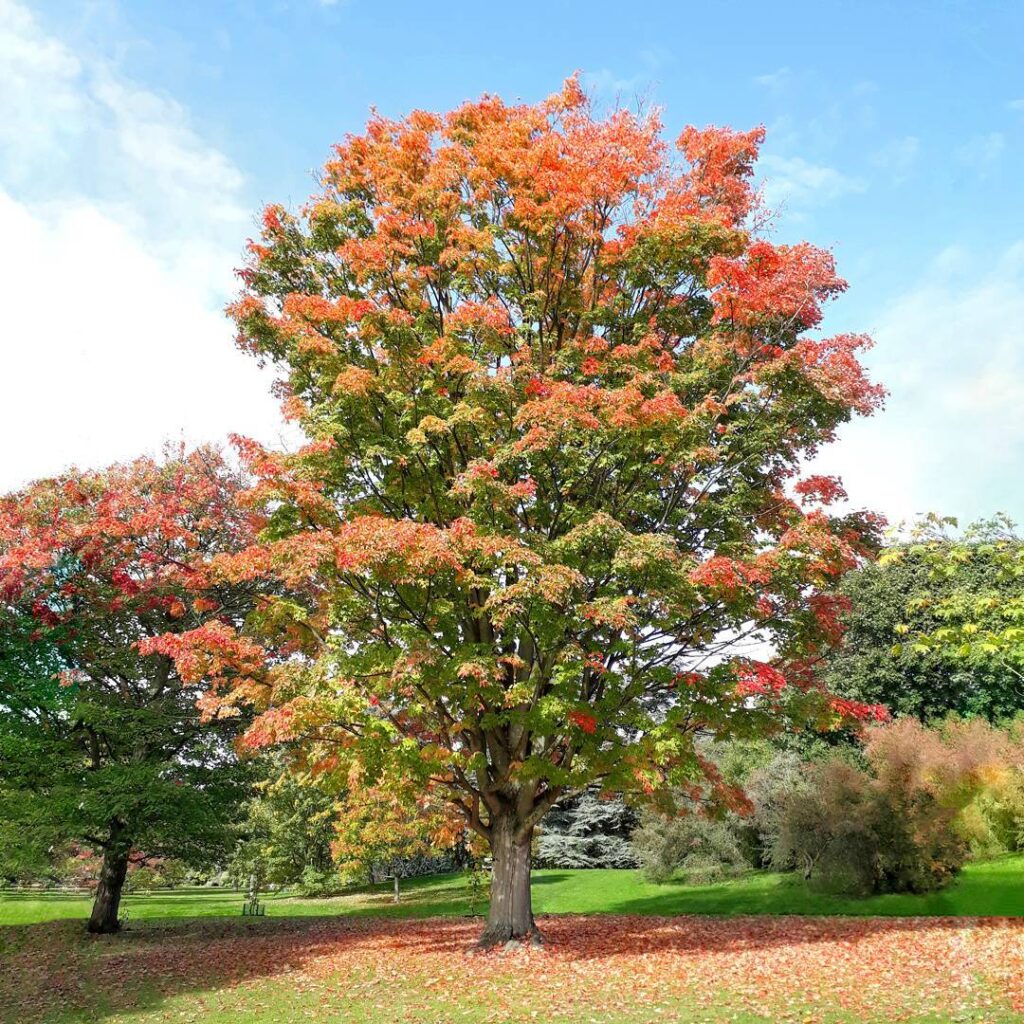
Sugar Maple (Acer saccharum) is a magnificent native deciduous tree that serves as a cornerstone species in Illinois woodlands. Reaching 60-75 feet tall with an upright branching structure, this large shade tree is prized for its spectacular fall foliage that transforms from dark green to brilliant yellows, oranges, and reds. Beyond its ornamental value, Sugar Maple provides essential wildlife habitat and is the primary source for maple syrup production.
This adaptable native thrives throughout Illinois, commonly becoming a dominant canopy tree in mesic woodlands, river valleys, and protected slopes. While it creates dense shade that benefits wildlife, gardeners should note that its thick canopy often inhibits turf growth beneath. Sugar Maple transplants well and offers longevity in appropriate settings, making it an excellent choice for parks and larger residential landscapes where space allows for its substantial mature size. The species displays distinctive palmate lobes on its 3-5 inch leaves, which help distinguish it from similar maple varieties.
- Hardiness: Zones 4-8
- Light: Full sun to light shade; tolerates moderate shade when young
- Water: Moist, well-drained conditions; intolerant of prolonged flooding
- Soil: Fertile loam preferred; tolerates sandy, silt-loam, clay-loam, and alkaline soils
- Fertilizer: Low maintenance; benefits from organic matter in soil
- Pest/Disease Resistance: Generally resistant; intolerant of road salt and acid rain
- Growth Rate: Moderate
American Basswood (Tilia Americana)
American Basswood (Tilia americana) is a majestic native shade tree that reaches 60-80 feet tall with a broad, rounded crown. This Illinois native produces fragrant yellow flowers in June that attract bees and earn it the nickname “Bee-tree.” The heart-shaped leaves with serrated edges create dense shade, making it an excellent specimen tree for residential landscapes and parks. Its ecological value extends beyond beauty, providing food for wildlife through its seeds and twigs while supporting pollinators with nectar-rich blooms. The flowers are accompanied by distinctive strap-shaped bracts that help distinguish this species from other trees.
- Hardiness: Zones 3-8 (thrives in northern Illinois zones 5-6)
- Light: Full sun (6+ hours daily) to partial shade (4-6 hours daily)
- Water: Prefers consistently moist, well-drained soil but tolerates occasional drought
- Soil: Adaptable to various soil types including alkaline and clay soils; best performance on deep, moist soils
- Fertilizer: Low maintenance; benefits from organic matter but generally not required
- Pest/Disease Resistance: Generally hardy but highly susceptible to ice damage
- Growth Rate: Moderate growth rate with vigorous development from sprouts and seeds
Red Oak (Quercus Rubra)

Red Oak (Quercus rubra) is a magnificent native Illinois shade tree that can reach 60-100 feet tall with a 60-75 foot spread. This fast-growing oak species features distinctive 5-8 inch lobed leaves that emerge pinkish-red in spring, mature to dark green in summer, and transform to brilliant russet-red in fall. Its straight trunk and rounded crown make it an excellent choice for large landscapes.
As one of the most adaptable oak species, Red Oak transplants easily and tolerates urban conditions including salt and air pollution. It serves dual purposes as both an outstanding landscape specimen and ecologically important native tree, supporting numerous wildlife species while providing valuable lumber. The tree produces acorns that mature over two years, providing an important food source for wildlife including mammals and birds. The tree’s seasonal color changes and sturdy structure make it ideal for parkways, large yards, and natural areas.
- Hardiness: Zones 3-7, very cold tolerant including northern Illinois
- Light: Full sun, requires high light levels for optimal performance
- Water: Moderate moisture needs, drought tolerant once established
- Soil: Adaptable to various soil types including clay and alkaline soils; prefers moist, well-drained, slightly acidic soil
- Fertilizer: Generally not needed in native soil conditions
- Pest/Disease Resistance: Good resistance, hardy in urban conditions
- Growth Rate: Fast-growing compared to other oak species
Eastern Red Cedar (Juniperus Virginiana)

Eastern Red Cedar is Illinois’ only native tree-sized juniper, found in every county throughout the state. This versatile evergreen can grow from shrub-like proportions of 3-5 feet to impressive trees exceeding 40 feet tall. Distinguished by its reddish-brown bark that splits into long shreds and blue-green scale-like foliage, it serves as an excellent pioneer species.
As a landscape plant, Eastern Red Cedar provides exceptional year-round wildlife value through dense evergreen shelter and blue berry-like cones that feed birds through winter. Its adaptability to poor soils and harsh conditions makes it perfect for windbreaks, erosion control, and low-maintenance landscaping in challenging sites. This dioecious tree produces pollen and seed cones on separate male and female trees.
- Hardiness: Cold hardy; tolerates harsh winter conditions
- Light: Full sun required for peak growth and dense foliage
- Water: Drought tolerant once established; minimal watering needed
- Soil: Highly adaptable to dry, rocky, sandy, and nutrient-poor soils
- Fertilizer: Low maintenance; requires minimal fertilization
- Pest/Disease Resistance: Good with proper spacing and occasional pruning
- Growth Rate: Rapid colonizer of open areas; fast establishment
Illinois Native Understory Shrubs
Illinois native understory shrubs offer diverse species ranging 2-10 feet tall, providing ecological benefits through wildlife support, adaptable growing conditions, and low-maintenance conservation value for gardens. Many species produce fragrant flowers that bloom from early spring through summer, creating sensory appeal while attracting beneficial pollinators and wildlife to the landscape.
Elderberry (Sambucus Canadensis)
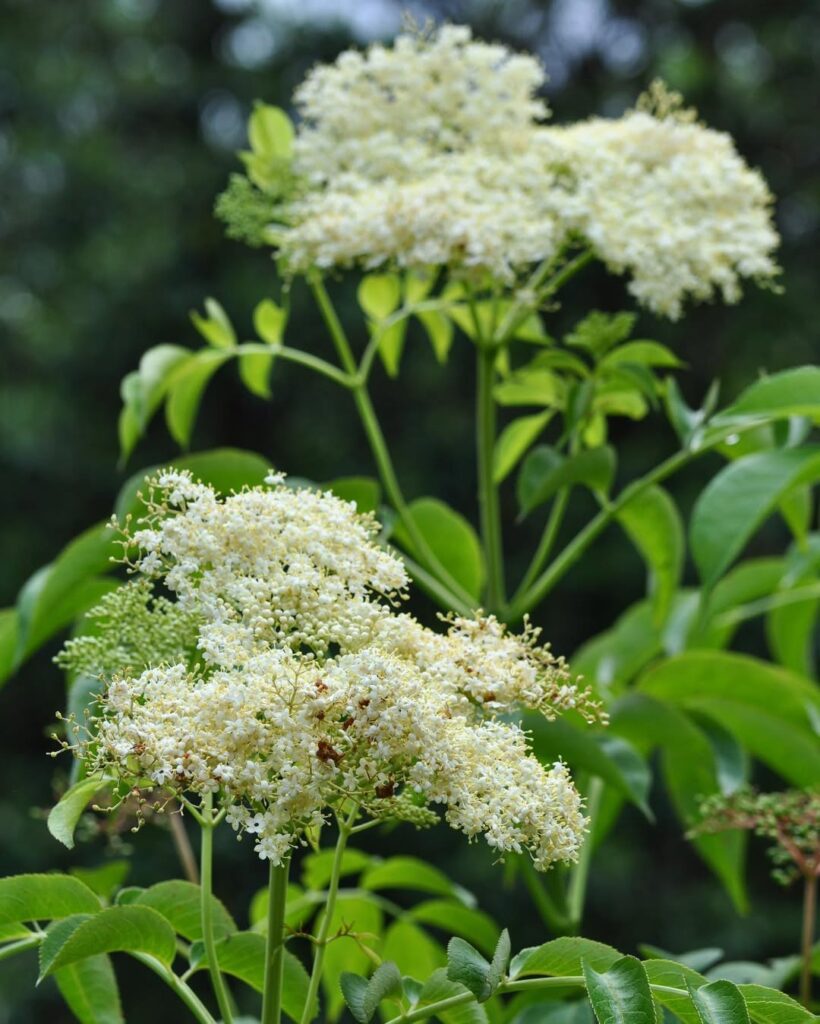
Elderberry (Sambucus canadensis) is a fast-growing, multi-stemmed deciduous shrub native to Illinois that reaches 5-12 feet tall and 6-10 feet wide. This adaptable pioneer species thrives in moist conditions and produces fragrant white flower clusters in summer followed by purple-black berries that are valuable for wildlife and culinary use when cooked.
As a low-maintenance native shrub, elderberry excels in naturalized settings, wildlife gardens, and erosion control applications. Its broad arching stems create dense cover while supporting pollinators during bloom and providing food for birds and small mammals through its abundant fruit clusters that persist into late summer. The plant can spread through clonal offsets that develop from underground rhizomes, making it effective for naturalizing larger areas.
- Hardiness: Native to all Illinois counties; cold hardy throughout the region
- Light: Full to partial sun (4-6+ hours direct sunlight daily)
- Water: Moist conditions preferred; tolerates brief flooding and occasional drought
- Soil: Moist, fertile, well-drained soils; adapts to clay, loam, sandy soils with organic matter; pH 6.0-8.0
- Fertilizer: Low requirements; benefits from organic matter in soil
- Pest/Disease Resistance: Generally resistant; low-maintenance
- Growth Rate: Fast-growing; establishes quickly under appropriate conditions
Spicebush (Lindera Benzoin)
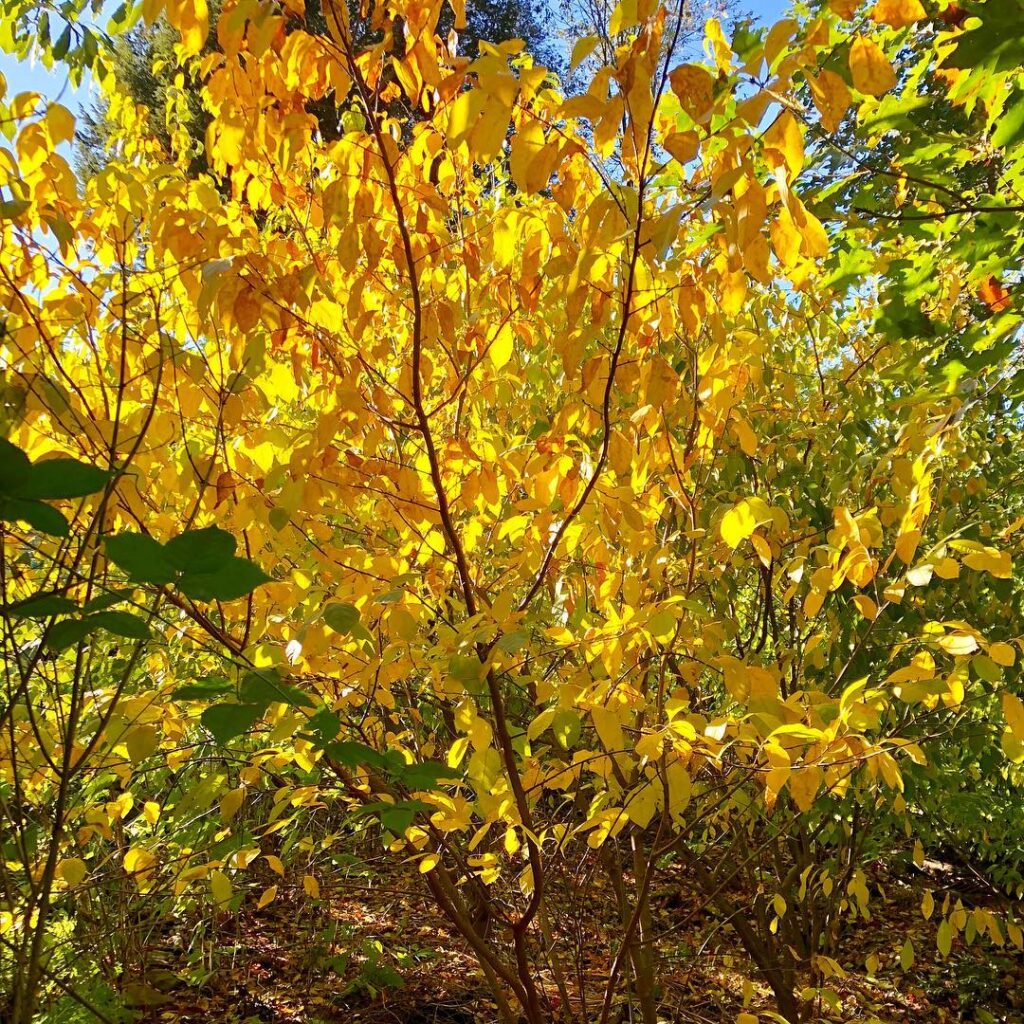
Spicebush (Lindera benzoin) is a deciduous, multi-stemmed shrub native to moist woodlands throughout the Midwest, including Illinois. Growing 5-15 feet tall and wide, this aromatic shrub produces fragrant yellow flowers in early spring before leaves emerge, followed by bright red berries on female plants in fall. The spicy-scented foliage turns vivid yellow in autumn.
As a dioecious species, individual plants are either male or female, requiring both for fruit production. Spicebush serves as an important host plant for Spicebush Swallowtail caterpillars and provides valuable food for migrating birds through its fat-rich berries. Early spring flowers offer vital nectar for native pollinators, making it an excellent choice for native plant gardens and naturalized landscapes. The shrub is particularly well-suited for rich deciduous woodlands and similar garden environments.
- Hardiness: USDA zones 4-9
- Light: Full sun to full shade; thrives in partial shade
- Water: Moist, well-drained soil; tolerates occasional drought and wet conditions
- Soil: Acidic to neutral pH; adapts to average garden soils
- Fertilizer: Low maintenance; typically requires no supplemental fertilization
- Pest/Disease Resistance: Generally pest and disease free
- Growth Rate: Moderate growth rate
Serviceberry (Amelanchier Canadensis)
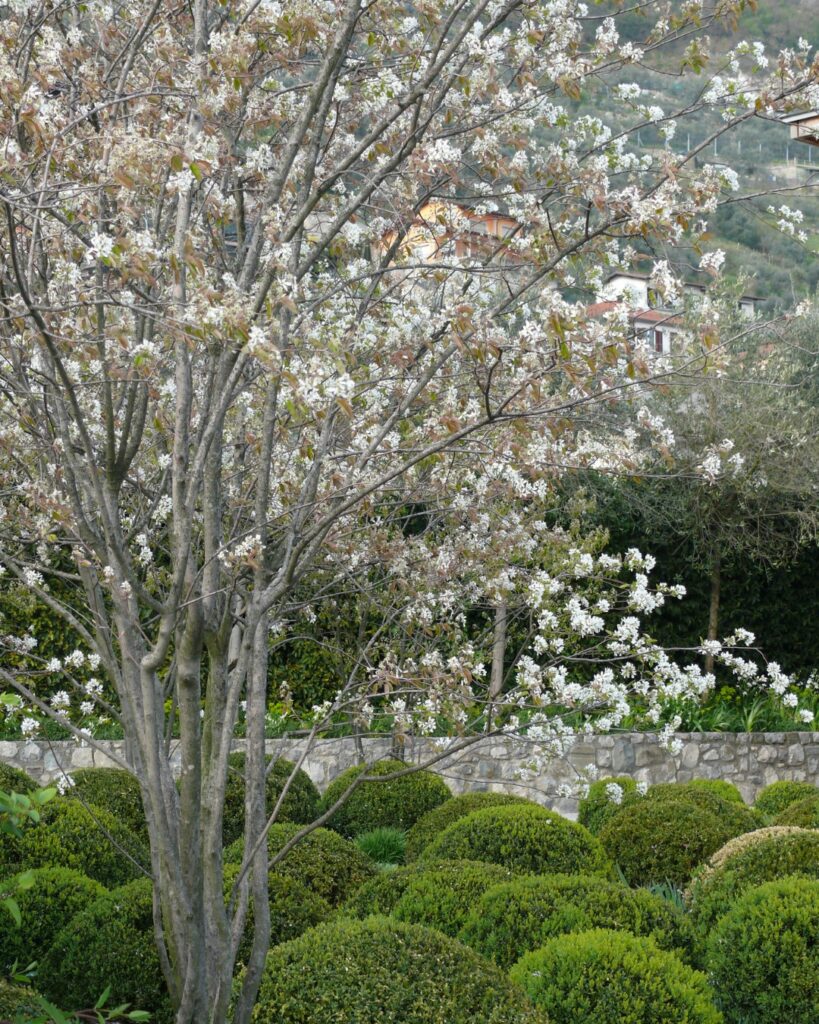
Serviceberry is a versatile native understory shrub that serves as an excellent alternative to invasive ornamental trees in Illinois landscapes. Growing 15-25 feet tall with a multi-stemmed form, this member of the Rosaceae family produces distinctive white, star-like flowers in early spring followed by sweet, purplish-black fruits that attract wildlife. The fruit is actually a pome fruit, like apples, rather than a true berry despite its common name. Its adaptability to various soil conditions and compact size make it ideal for small urban spaces while providing four-season interest through spring blooms, summer berries, vibrant fall foliage, and attractive winter bark structure.
- Hardiness: USDA zones 3-7, suitable throughout Illinois
- Light: Minimum 4 hours of direct sunlight daily for peak growth
- Water: Adaptable from fairly dry to occasionally wet conditions; tolerates flooding
- Soil: Wide range of soil types, particularly well-suited for wet sites
- Fertilizer: Low maintenance; typically does not require supplemental fertilization
- Pest/Disease Resistance: Generally resistant with few serious pest or disease issues
- Growth Rate: Moderate growth rate with colony-forming tendency
Ninebark (Physocarpus Opulifolius)
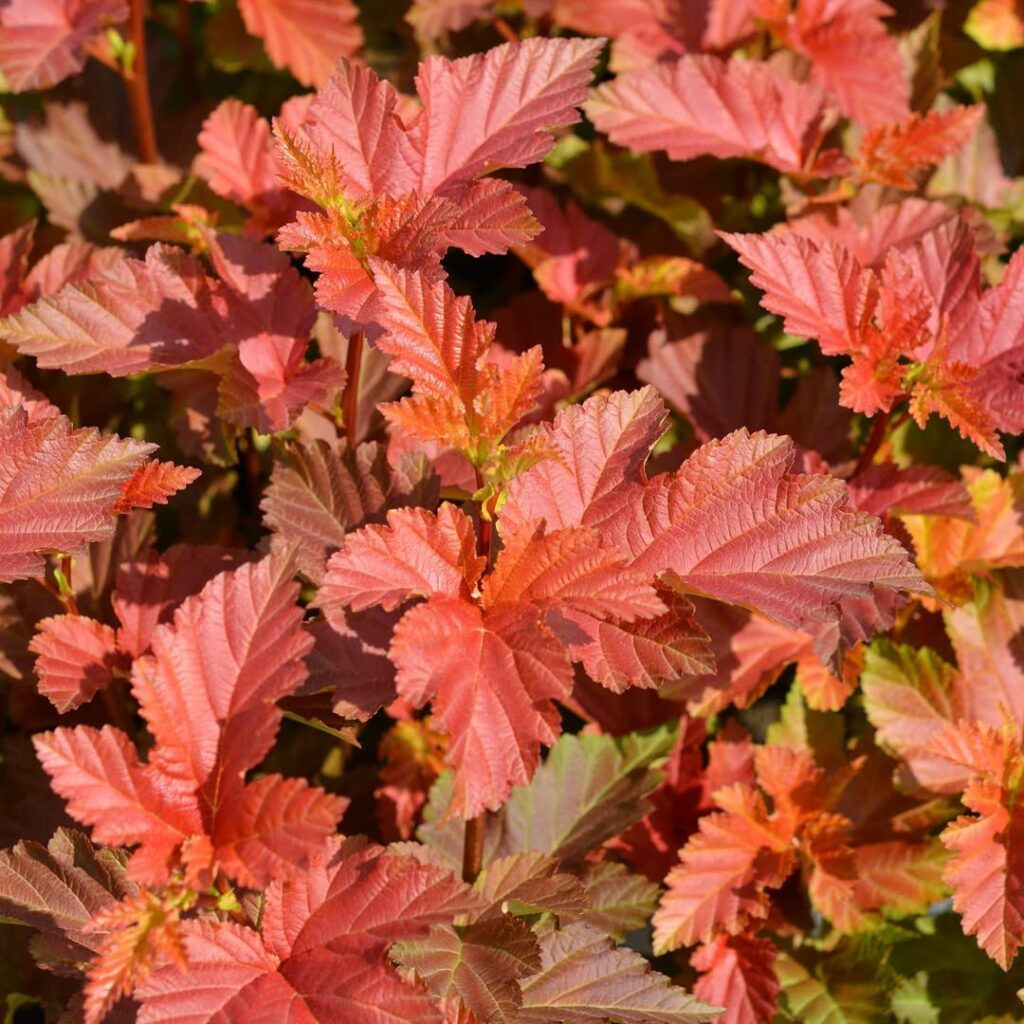
Ninebark is Illinois’ only native Physocarpus species, forming a multi-stemmed shrub reaching 5-10 feet tall with distinctive arching branches. This adaptable understory plant features exfoliating bark that reveals attractive reddish-brown layers, making it valuable for year-round garden interest. The dark green lobed leaves turn yellow-bronze in fall, complementing clusters of white to pinkish spring flowers that develop into persistent reddish-pink seed capsules.
Beyond its ornamental appeal, ninebark serves essential ecological functions as a host plant for native moths and attracts diverse pollinators including bees. Its dense branching provides excellent nesting habitat for birds while offering erosion control on slopes and streambanks. The plant thrives in various soil types including loamy, sandy, and rocky conditions. This low-maintenance shrub integrates beautifully into native plantings, mixed borders, and naturalized landscapes throughout Illinois.
- Hardiness: USDA zones 2-8
- Light: Full sun to partial shade
- Water: Evenly moist, well-drained; tolerates drought and occasional flooding
- Soil: Adaptable to clay, rocky, sandy, and alkaline soils
- Fertilizer: Low requirements; moderate fertility supports ideal growth
- Pest/Disease Resistance: Generally pest and disease resistant
- Growth Rate: Moderate
Gray Dogwood (Cornus Racemosa)

Gray Dogwood (Cornus racemosa) is a versatile native shrub that forms extensive thickets throughout Illinois. This multi-stemmed deciduous plant reaches 8-16 feet tall and spreads 10-15 feet wide through suckering. It produces clusters of creamy white flowers from May to July, followed by distinctive white berries on striking red stems in late summer. The gray-green foliage transforms to beautiful burgundy-red in fall.
This adaptable shrub thrives in diverse habitats from woodlands to prairies, making it valuable for naturalized landscapes and wildlife habitat. Its dense, twiggy growth provides excellent cover and nesting sites for birds, while the berries serve as an important food source. The species demonstrates remarkable resilience by spreading in response to disturbances such as wildfires and selective logging. Gray Dogwood is particularly useful for erosion control and challenging sites, though its vigorous spreading nature makes it better suited for informal or naturalized settings rather than small formal gardens.
- Hardiness: USDA Zones 3-8
- Light: Full sun to full shade; prefers partial to full sun
- Water: Moist to mesic conditions preferred; tolerates occasional drought and periodic flooding
- Soil: Adaptable to various soil types including loamy, rocky, clay, alkaline, dry, and wet soils
- Fertilizer: Generally not needed; thrives in natural conditions
- Pest/Disease Resistance: Good resistance; withstands urban conditions
- Growth Rate: Slow growth rate; spreads via suckering to form colonies
Selecting the Right Native Plants for Your Garden
When you’re choosing native plants for your Illinois garden, you’ll want to focus on species that naturally thrive in the state’s challenging clay soil and extreme seasonal swings. Start by sourcing seeds from within 50 miles of your planting site for best adaptation. For areas under 1,000 square feet, transplants deliver quicker results, while seeds work better for larger spaces. Smart native plant combinations group species with similar water and light needs together. Always check mature plant sizes before buying, and select healthy specimens with strong root systems. These garden maintenance tips guarantee you’ll create sustainable landscapes requiring minimal fertilizer and watering. Consider incorporating salt-tolerant native plants if your garden is located near roadways or areas that receive salt runoff during winter months.
Frequently Asked Questions
Where Can I Purchase Native Illinois Plants and Seeds Locally?
You’ll find native plant nurseries like The Growing Place in Naperville offering regional selections. Check Pleasant Prairie Nursery for online ordering, explore local seed swaps through Wild Ones chapters, or visit Genesis Nursery for restoration projects.
How Do I Remove Invasive Species Before Planting Native Plants?
You’ll need proper invasive species removal before planting. Cut woody invasives during dormant seasons, hand-pull annuals before seeding, then apply targeted herbicides to stumps. This maximizes native plant benefits and establishment success.
What Is the Best Time of Year to Plant Native Species?
While winter’s harsh grip seems hostile to growth, it’s actually nature’s perfect preparation. You’ll find fall planting ideal for seeds needing cold stratification, though spring planting works better for transplants.
Do Native Plants Require Special Fertilizers or Soil Amendments?
You don’t need special fertilizers for native plant care since these species thrive in natural conditions. Focus on soil health through testing first – most Illinois soils provide adequate nutrients without amendments for healthy native growth.
How Long Does It Take for Native Plants to Become Established?
Your native plants need two years for basic establishment timeline, but full maturity takes three to five years. Growth factors like soil preparation, planting season, and species selection greatly affect how quickly they’ll anchor and thrive.
